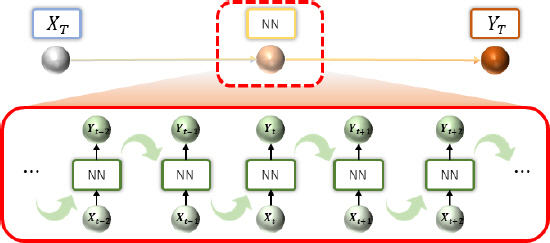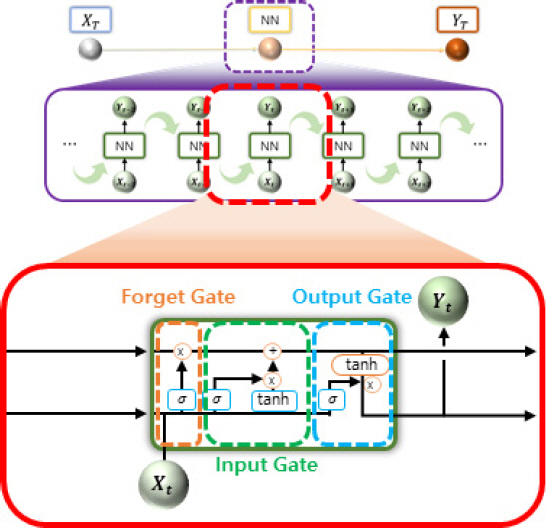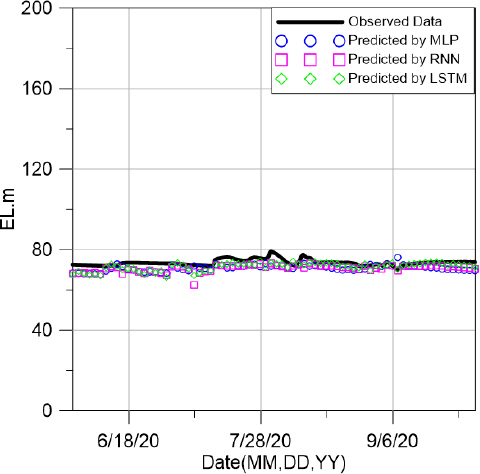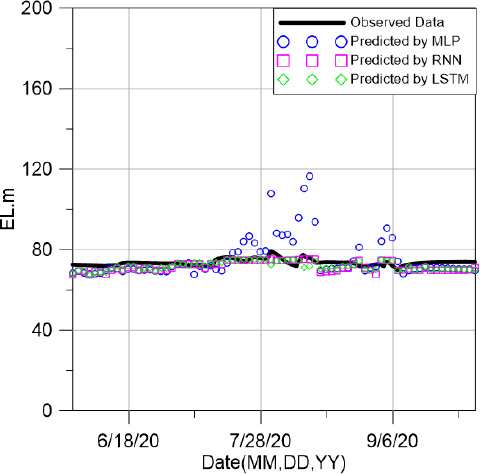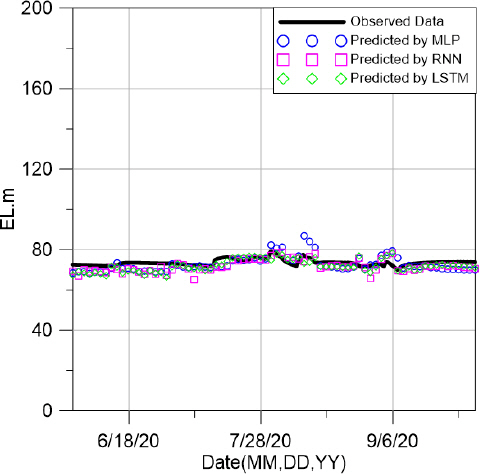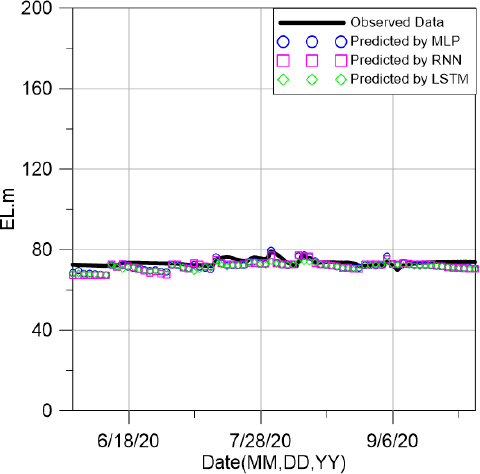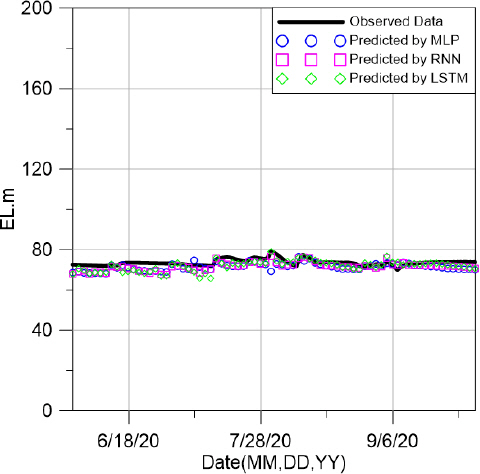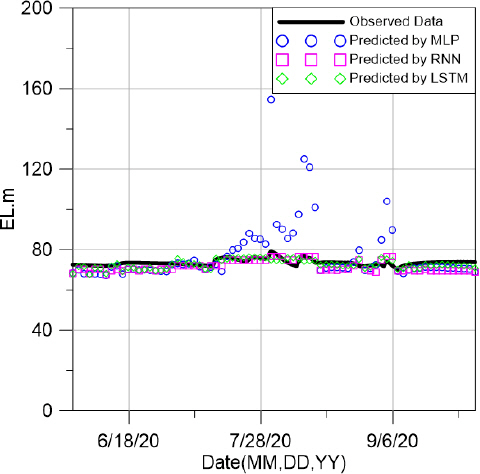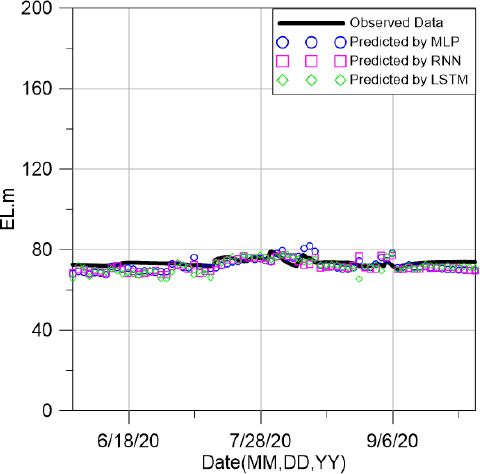1. Abrahart, R, Kneale, P.E, and See, L.M (2004) Neural networks for hydrological modeling.
CRC Press, London, UK.

2. Assem, H, Ghariba, S, Makrai, G, Johnston, P, Gill, L, and Pilla, F (2017) Urban water flow and water level prediction based on deep learning.
Joint European conference on machine learning and knowledge discovery in databases. Springer, Skopje, Macedonia, Vol. 3, pp. 317-329.

3. Bae, Y, Kim, J, Wang, W, Yoo, Y, Jung, J, and Kim, H.S (2019) Monthly inflow forecasting of Soyang River dam using VARMA and machine learning models.
Journal of Climate Research, Vol. 14, No. 3, pp. 183-198.

4. Bicknell, B.R, Imhoff, J.C, Kittle, J.L Jr, Donigian, A.S Jr, and Johanson, R.C (1996) Hydrological simulation programFORTRAN.
User's manual for release 11. EPA, U.S.

5. Bl├Čschl, G, Hall, J, Viglione, A, Perdig├Żo, R.A, Parajka, J, Merz, B, et al (2019) Changing climate both increases and decreases European river floods.
Nature, Vol. 573, No. 7772, pp. 108-111.



6. Chen, L, Singh, V.P, Lu, W, Zhang, J, Zhou, J, and Guo, S (2016) Streamflow forecast uncertainty evolution and its effect on real-time reservoir operation.
Journal of Hydrology, Vol. 540, pp. 712-726.

7. Chen, P.A, Chang, L.C, and Chang, F.J (2013) Reinforced recurrent neural networks for multi-step-ahead flood forecasts.
Journal of Hydrology, Vol. 497, pp. 71-79.

8. Choi, C, Kim, J, Han, H, Han, D, and Kim, H.S (2020) Development of water level prediction models using machine learning in wetlands:A case study of Upo Wetland in South Korea.
Water, Vol. 12, No. 1, pp. 93-110.

9. Devia, G.K, Ganasri, B.P, and Dwarakish, G.S (2015) A review on hydrological models.
Aquatic Procedia, Vol. 4, pp. 1001-1007.

10. Ghumman, A.R, Ghazaw, Y.M, Sohail, A.R, and Watanabe, K (2011) Runoff forecasting by artificial neural network and conventional model.
Alexandria Engineering Journal, Vol. 50, No. 4, pp. 345-350.

11. Granata, F, Gargano, R, and De Marinis, G (2016) Support vector regression for rainfall-runoff modeling in urban drainage:A comparison with the EPA's storm water management model.
Water, Vol. 8, No. 3, pp. 69-81.

12. Han, H, Choi, C, Jung, J, and Kim, H.S (2021) Application of sequence to sequence learning based LSTM model (LSTM-s2s) for forecasting dam inflow.
Journal of Korea Water Resources Association, Vol. 54, No. 3, pp. 157-166.

13. Hochreiter, S, and Schmidhuber, J (1997) Long short-term memory.
Neural computation, Vol. 9, No. 8, pp. 1735-1780.


14. Jung, S.H, Lee, D.E, and Lee, K.S (2018) Prediction of river water level using deep-learning open library.
Journal of the Korean Society of Hazard Mitigation, Vol. 18, No. 1, pp. 1-11.

15. Kang, N.R, Noh, H.S, Lee, J.S, Lim, S.H, and Kim, H.S (2013) Runoff simulation of an urban drainage system using radar rainfall data.
Journal of Wetlands Research, Vol. 15, No. 3, pp. 413-422.

16. Kim, B.K, Kim, S.D, Lee, E.T, and Kim, H.S (2007) Methodology for estimating ranges of SWAT model parameters:Application to Imha Lake inflow and suspended sediments.
Journal of the Korean Society of Civil Engineers, Vol. 27, No. 6B, pp. 661-668.

17. Kim, D, Kim, J, Kwak, J, Necesito, I.V, Kim, J, and Kim, H.S (2020) Development of water level prediction models using deep neural network in mountain wetlands.
Journal of Wetlands Research, Vol. 22, No. 2, pp. 106-112.

18. Kim, K.S (2010) A study on the real time forecasting for monthly inflow daecheong dam using hydrologic time series analyses.
Master Thesis, Seokyeong University, pp. 32-54.

19. Lee, K, Choi, C, Shin, D.H, and Kim, H.S (2020) Prediction of heavy rain damage using deep learning.
Water, Vol. 12, No. 7, pp. 1942-1959.

20. Mahsa, M, and Lee, T (2018) Comparison of optimization algorithms in deep learning-based neural networks for hydrological forecasting:Case study of nam river daily runoff.
Journal of the Korean Society of Hazard Mitigation, Vol. 18, No. 6, pp. 377-384.


21. Mok, J.Y, Choi, J.H, and Moon, Y.I (2020) Prediction of multipurpose dam inflow using deep learning.
Journal of Korea Water Resources Association, Vol. 53, No. 2, pp. 97-105.

22. Montanari, A, Rosso, R, and Taqqu, M.S (1997) Fractionally differenced ARIMA models applied to hydrologic time series:Identification, estimation, and simulation.
Water Resources Research, Vol. 33, No. 5, pp. 1035-1044.

23. Mosavi, A, Ozturk, P, and Chau, K.W (2018) Flood prediction using machine learning models:Literature review.
Water, Vol. 10, No. 11, pp. 1536.

24. Neitsch, S.L, Arnold, J.G, Kiniry, J.R, and Williams, J.R (2011) Soil and water assessment tool theoretical documentation version 2009.
Texas Water Resources Institute, Temple, TX.

25. Noh, H, Lee, J, Kang, N, Lee, D, Kim, H.S, and Kim, S (2016) Long-term simulation of daily streamflow using radar rainfall and the SWAT model:A case study of the Gamcheon basin of the Nakdong River, Korea.
Advances in Meteorology, Vol. 2016, pp. 431-442.

27. Palmer, M, and Ruhi, A (2019) Linkages between flow regime, biota, and ecosystem processes:Implications for river restoration.
Science, Vol. 365, No. 6459, pp. eaaw2087.


28. Park, M.K, Yoon, Y.S, Lee, H.H, and Kim, J.H (2018) Application of recurrent neural network for inflow prediction into multi-purpose dam basin.
Journal of Korea Water Resources Association, Vol. 51, No. 12, pp. 1217-1227.

29. Ramachandran, P, Zoph, B, and Le, Q.V (2017) Searching for activation functions.
arXiv preprint arXiv:1710.05941.

30. Riad, S, Mania, J, Bouchaou, L, and Najjar, Y (2004) Predicting catchment flow in a semi-arid region via an artificial neural network technique.
Hydrological Processes, Vol. 18, No. 13, pp. 2387-2393.

31. Shoaib, M, Shamseldin, A.Y, Melville, B.W, and Khan, M.M (2016) A comparison between wavelet based static and dynamic neural network approaches for runoff prediction.
Journal of Hydrology, Vol. 535, pp. 211-225.

32. Yan, J, Jin, J, Chen, F, Yu, G, Yin, H, and Wang, W (2018) Urban flash flood forecast using support vector machine and numerical simulation.
Journal of Hydroinformatics, Vol. 20, No. 1, pp. 221-231.


33. Zhang, Q, Xiao, M, Singh, V.P, and Li, J (2012) Regionalization and spatial changing properties of droughts across the Pearl River basin, China.
Journal of Hydrology, Vol. 472, pp. 355-366.






